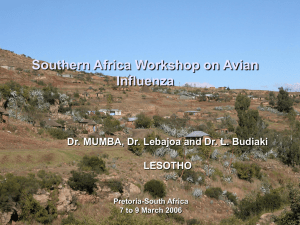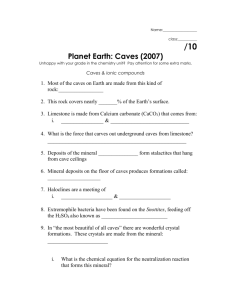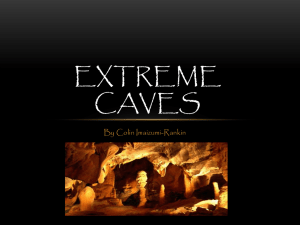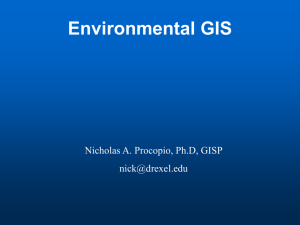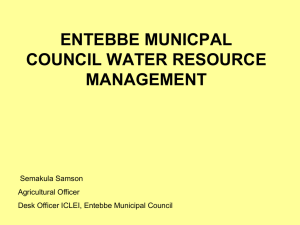Student activity
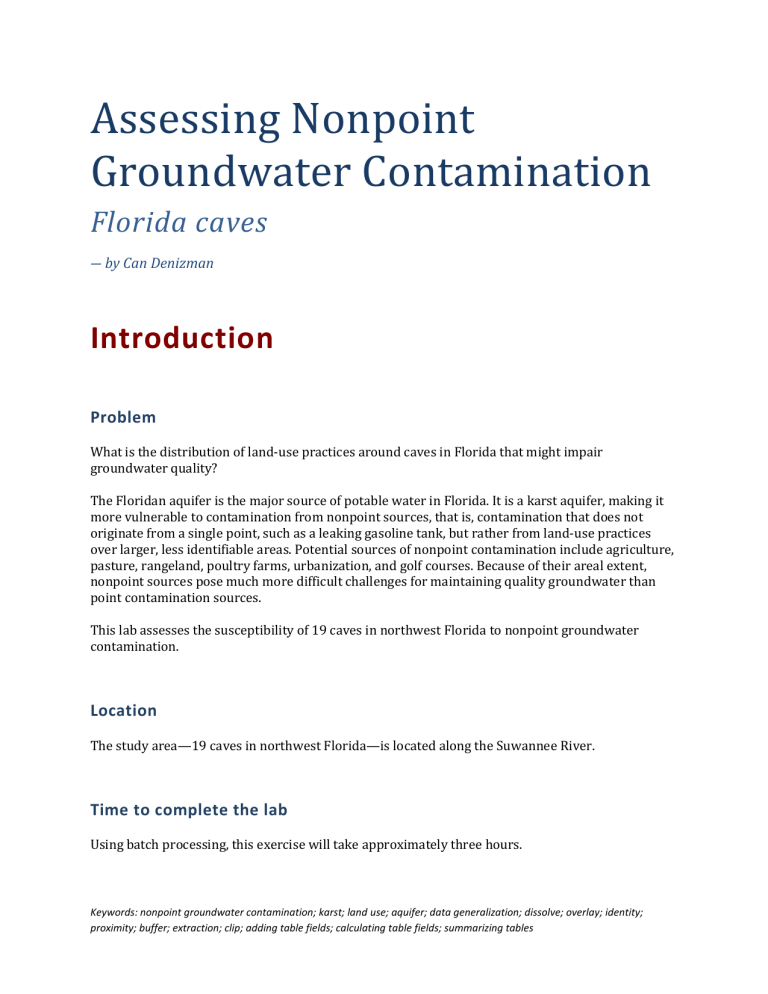
Assessing Nonpoint
Groundwater Contamination
Florida caves
― by Can Denizman
Introduction
Problem
What is the distribution of land-use practices around caves in Florida that might impair groundwater quality?
The Floridan aquifer is the major source of potable water in Florida. It is a karst aquifer, making it more vulnerable to contamination from nonpoint sources, that is, contamination that does not originate from a single point, such as a leaking gasoline tank, but rather from land-use practices over larger, less identifiable areas. Potential sources of nonpoint contamination include agriculture, pasture, rangeland, poultry farms, urbanization, and golf courses. Because of their areal extent, nonpoint sources pose much more difficult challenges for maintaining quality groundwater than point contamination sources.
This lab assesses the susceptibility of 19 caves in northwest Florida to nonpoint groundwater contamination.
Location
The study area—19 caves in northwest Florida—is located along the Suwannee River.
Time to complete the lab
Using batch processing, this exercise will take approximately three hours.
Keywords: nonpoint groundwater contamination; karst; land use; aquifer; data generalization; dissolve; overlay; identity; proximity; buffer; extraction; clip; adding table fields; calculating table fields; summarizing tables
Assessing Nonpoint Groundwater Contamination: Florida Caves
Prerequisites
Intermediate GIS experience is required.
Data used in this lab
Caves (prepared by Can Denizman for the Florida Geological Survey)
2004 Land Use (Suwannee River Water Management District [SRWMD])
Geographic coordinate system: GCS_North_American_1983_HARN
Datum: D_North_American_1983_HARN
Projection: Albers conical equal area (Florida Geographic Data Library)
Can Denizman
Student activity
A geospatial approach to groundwater contamination potential requires some background information about groundwater storage and movement. Usually, groundwater flow is slow, and recharge to the aquifer takes place by diffuse infiltration through the overlying geologic units.
Contaminant plumes attenuated by dense aquifer material do not spread rapidly.
Karst aquifers are a different story. This is because most groundwater storage and flow in karst aquifers occur in enlarged cavities, conduits, and caves formed by the dissolution of aquifer material such as limestone, dolomite, and gypsum. Through them, groundwater contamination can spread long distances over short periods of time. Karst aquifers are susceptible to groundwater contamination for the following reasons (see figure 2):
There is a close interaction between surface water and groundwater in karst aquifers.
Surface water readily combines with groundwater through sinkholes. It is very common to see disappearing streams in karst regions, making groundwater susceptible to surficial contamination.
Once in the karst aquifer, water moves rapidly through solutional conduits and caves with very little natural filtration and remediation.
2
Assessing Nonpoint Groundwater Contamination: Florida Caves Can Denizman
Figure 1. Susceptibility of karst aquifers to groundwater contamination
As one of the most productive aquifers in the world, the Floridan aquifer is a karst type with extensive dissolution channels, cave systems, and springs resulting in significant groundwater discharge. Because of the vulnerability of karst aquifers to surficial contamination, we should be very concerned about the land-use practices in areas where the Floridan aquifer is unconfined (i.e., not covered by a thick impermeable geologic unit). We are especially interested in the distribution around caves of potential nonpoint contamination sources, such as agriculture, poultry, pasture, and rangeland.
3
Assessing Nonpoint Groundwater Contamination: Florida Caves Can Denizman
Figure 2. The study area along Suwannee River, Florida, composed of caves and aquifers
Your goal is to determine the land-use distribution above and around 19 caves in northwest
Florida. (All these caves are phreatic—filled with groundwater—and formed within the Floridan aquifer.) You can do this by applying a number of geographic information system (GIS) analysis tools toward accomplishing two general tasks:
4
Assessing Nonpoint Groundwater Contamination: Florida Caves Can Denizman
Determine land-use distribution above and around the caves by overlaying cave shapefiles on the land-use layer and extracting land-use information.
Calculate the areal distribution of land-use practices for each cave.
The GIS application for this lab employs a number of overlay operations between the caves and the land-use data. The tasks are
Organize the directory structure.
Review and process the data.
Overlay cave polylines on land-use polygons and obtain land-use information for cave passages.
Overlay buffered cave lines on land use and extract land-use information for the areas around the cave.
Perform table operations to calculate land-use percentages.
Use summary tables to create pie charts.
L AND USE DISTRIBUTION ABOVE THE CAVES
In the first part of the lab, you will begin to assess how susceptible to nonpoint contamination caves might be by identifying land-use distribution above the caves. To determine land-use classifications directly above the passages of 19 caves in northwest Florida, you will overlay cave shapefiles on the land-use layer.
P ROCESS DATA
1 Start ArcCatalog and create the following folders in your workspace:
…\nonpoint_cont\luse_clips
…\nonpoint_cont\summary_tables
…\nonpoint_cont\two_km_buffers
You must organize the directory structure in this way before you start processing data.
2 Start ArcMap and open the map document nonpoint_contamination_partI.mxd
. If red exclamation points appear next to the check boxes for each layer, click one of the check boxes and designate the source.
3
Rename and save the map document in your own folder using
Save As
.
5
Assessing Nonpoint Groundwater Contamination: Florida Caves Can Denizman
4 Explore the data. You see 19 polyline shapefiles of caves under the heading Florida Land Use and Caves and the SRWMD 2004 Land Use polygon shapefile, which shows land-use classifications in 2004 within the Suwannee River Water Management District.
5 Open ArcToolbox and review the Analysis tools. Which group of Analysis tools do you think you need?
Since this geospatial approach involves a spatial intersection between the cave layers and the landform layer, use Overlay tools.
6 Double-click Overlay then Identity .
It seems like the identity tool will provide what is needed. You can overlay caves (Input
Features) on land use (Identity Features) and obtain all the land-use information for polygons that intersect each cave. During the Identity operation, land-use information will be appended to the attribute table of the Output Feature Class.
P
REPARE FOR THE OVERLAY
Merge
So, all you need is a simple Identity operation. However, it seems like you will need 19 Identity operations for all the caves. How can you do everything in one step? Batch processing is one option.
You see the batch option when you right-click the
Identity
tool in ArcToolbox. That would implement the process for all 19 caves at once. However, you would end up with 19 new shapefiles.
There must be a better way to do the overlay. How about merging all the caves in one shapefile before the overlay?
1 To find the Merge tool in ArcToolbox, bring up the Search window, click the Tools item, and type merge . Click Merge(Data
Management) to open the command window, then click Show Help/Tool Help .
Read the description of the tool. The Merge tool will provide a single shapefile that includes all the caves in the data frame.
2 Input each cave one by one by dragging the files into the Input Datasets section of the
Merge dialog box.
3 Save the output as merged_caves in your own folder.
Figure 3. Performing a search for the Merge tool
6
Assessing Nonpoint Groundwater Contamination: Florida Caves Can Denizman
4 In the Field Map (Optional) window, delete all the attributes (fields) except ID and Cave. Most of the deleted attributes describe the morphological features of caves and will not be needed. You need the attribute Cave, which contains the name of each cave, to find out which passage in the merged shapefile belongs to which cave.
5 Click OK (figure 4).
Figure 4. Using the Merge tool
6 Now that you have a merged_caves shapefile that comprises all the caves, open the attribute table and explore it.
Even with only 19 caves, there are hundreds of line segments. For example, the Alachua cave is represented by 16 line segments. How can you have one line segment for each cave?
7
Assessing Nonpoint Groundwater Contamination: Florida Caves
Dissolve
1 In the Generalization tools under
Data Management in ArcToolbox, read about Dissolve—it aggregates features based on specified attributes. You can aggregate the cave passages based on the Cave attribute (the cave name for each passage).
2 Use merged_caves for Input Features and make sure the Output Feature
Class is saved in your folder. Keep the default name
(merged_caves_Dissolve). Select
Cave for Dissolve_Field(s) . Click OK
(figure 5).
3
Explore the new shapefile.
Compare it with the merged_caves shapefile. Open the attribute table.
Now you have a much simpler shapefile with only 19 records— one record for each cave.
Figure 5. Using the Dissolve tool
Can Denizman
8
Assessing Nonpoint Groundwater Contamination: Florida Caves Can Denizman
O
VERLAY
1 To begin the overlay operation, double-click Identity in ArcToolbox (in Analysis Tools » Overlay ).
Select merged_caves_Dissolve
for
Input Features
and
SRWMD 2004 Land Use
for
Identity Features
.
Keep the default name for the Output Feature Class but make sure it is saved in your own folder.
Click OK (figure 6).
Figure 6. Using the Identity tool
2 Explore the new shapefile (merged_caves_Dissolve_Identi) and its attribute table. You see many attributes in the table. All the necessary information you need about land use is stored in the field LEVEL1. You also need the cave names stored in the Cave attribute.
3 To make all the other attributes invisible, close the table, right-click the shapefile name, and select Properties . Click the Fields tab and uncheck all the boxes except for LEVEL1 and Cave. Click
OK (figure 7).
9
Assessing Nonpoint Groundwater Contamination: Florida Caves Can Denizman
Figure 7. Making only selected attributes visible
4 Open the attribute table again. Now you have just the attributes you need for the analysis: cave names and land-use classifications.
P ERFORM TABLE OPERATIONS
Your ultimate goal is to calculate land-use percentages above the caves. This will enable you to determine which caves are more at risk for nonpoint source contamination.
The table displays each cave segment with its corresponding land-use categories. However, this does not reveal anything about the distribution of land-use categories for the length of each cave segment.
10
Assessing Nonpoint Groundwater Contamination: Florida Caves Can Denizman
Add and calculate a new field
1 To add a new field for cave length, in the attribute table, click Table Options (the leftmost button) and choose Add Field . In the Add Field dialog box, enter Length_m for Name . Select Double and enter
10
for
Precision
and
1
for
Scale
. Click
OK
.
2
To populate this new field called Length_m with length values for each segment, right-click the
Length_m
header cell and select
Calculate Geometry
. Select
Yes
if asked if you would like to calculate outside an edit session. Property is length, and the unit is meters [m]. Keep the default for the Coordinate System. Click
OK
(figure 8).
Figure 8. Calculating geometry
3
Zoom in to the map and compare length values for various segments with the values from the
Measure tool in ArcMap.
11
Assessing Nonpoint Groundwater Contamination: Florida Caves Can Denizman
Now you have cave length values for each land-use classification. But how can you find the total length of cave passages for each land-use classification? This requires another table operation called
Summarize
. It creates a summary table for each cave. Again, begin with the first cave in the table, Alachua.
Create summary tables
1 Select all the Alachua records either using Select by Attributes or by pressing SHIFT and clicking the Alachua records. All subsequent table operations will be performed on the selected records.
2
Right-click the
LEVEL1
header cell and select
Summarize
. In the dialog box, click the plus sign next to Length_m and check the Sum box. Save as Alachua_Summary.dbf
in the
…/summary_tables folder. Save as type dBASE Table . Click OK and Yes to add the table to the data frame (figure 9).
A summary table for the Alachua cave is generated and added to the data frame.
Figure 9. Creating a summary table for a selected cave to calculate passage-length values for different land-use categories
12
Assessing Nonpoint Groundwater Contamination: Florida Caves Can Denizman
3 Click the List by Source button in the data frame to see the table at the bottom. Right-click and open it. Corresponding passage-length values of Alachua Cave for different land-use categories are summarized in this table.
How can you express each land-use category as a percentage of the total passage length? To calculate percentages, you need to know the total length of passages in the Alachua cave.
4 Add a new field called Percentage to the summary table. It is a short integer with a precision of
0.
5
Right-click the
Sum_Length_m
header cell and select
Statistics
. The sum (total length) is 668.8 m.
6 Right-click the Percentage header cell and select Field Calculator . Enter the following statement:
[Sum_Length]*100/668.8. Select Yes if asked if you would like to calculate outside an edit session.
7 Click OK (figure 10).
Figure 10. Using the Field Calculator
Now, you have calculated the percentage of each land use for Alachua Cave. Repeat the “Create summary tables” steps above to generate summary tables for each cave or selected caves.
13
Assessing Nonpoint Groundwater Contamination: Florida Caves Can Denizman
Based on your calculations so far, which caves are more susceptible to nonpoint source contamination originating from land use around them involving agriculture, pasture, rangeland, poultry farms, urbanization, and golf courses?
8 Save and close the map document.
L AND USE DISTRIBUTION AROUND THE CAVES
What are the land-use practices within 2 km of the caves? Determining this requires another overlay operation, but this time it will be a polygon-on-polygon overlay between the land-use and cave-buffer polygons. The specific tasks are
Buffering cave polylines
Clipping land use with each cave buffer polygon
Summarizing land use in the cave buffer to determine areal percentage of each land-use classification
1 Start ArcMap and open the map document nonpoint_contamination_partII.mxd.
2
Save the map document in your own folder using
Save As
.
The cave polylines in the data frame consist of many segments with various passage parameters. The buffer operation requires single line shapefiles of the caves, so you will use the dissolved cave shapefiles.
3 Remove all the cave shapefiles, merged files, and tables from the data frame.
You need to create a 2 km buffer around each cave. Do this one by one for all 19 caves or use the batch processing feature of the Buffer tool. You can’t merge them and buffer the merged layer, because most of the buffers will overlap.
4 In ArcToolbox, under Analysis Tools »
Proximity , right-click Buffer and select
Batch (figure 11).
Figure 11. Location of the Batch option of the Buffer tool in
ArcToolbox
14
Assessing Nonpoint Groundwater Contamination: Florida Caves Can Denizman
5 Fill the batch-buffer dialog box for each cave and click
OK
. Make sure the output shapefiles are saved under
…\nonpoint_cont\two_km_buffers and the value in the Distance field is 2 kilometers)
(figures 12 and 13).
6
Double-click the
Output Feature Class
field to bring up the browser window.
Figure 12. Using the Batch option of the Buffer tool
Figure 13. Using the Batch option of the Buffer tool
15
Assessing Nonpoint Groundwater Contamination: Florida Caves
7 Explore the cave buffer shapefiles (figure 14).
Can Denizman
Figure 14. The resulting cave-buffer shapefiles
8 Now, you are ready for clip operations. In ArcToolbox, right-click Clip ( Analysis Tools » Extract »
Clip ). Fill the batch clip window. You will be clipping the land use (Input Feature) with buffered caves (Clip Feature). Save the output clip shapefiles under …\nonpoint_cont\luse_clips.
9
You now have 19 polygon shapefiles that show land-use classification around each cave. To calculate their areal percentage, open the attribute table for each clip shapefile and add two new fields: Area, Double, 10, 1; and Percentage, Double, 5, 1.
10
Calculate area in square meters for the
Area
field.
11 Calculate percentage of area for the Percentage field.
12 Summarize each table for the LEVEL1 attribute and the sum of Percentage. Name them as (cave name)_buffer_summary.dbf, save as type dBASE Table and save under
…\nonpoint_cont\summary_tables (figure 15).
16
Assessing Nonpoint Groundwater Contamination: Florida Caves Can Denizman
Figure 15. Viewing the summarized land-use areas and percentages within the cave buffers
V ISUALIZE
Creating pie charts from the data will aid you in communicating the information. You can do this in two ways:
Export all summary tables as .dbf files, open them in a spreadsheet, and create pie charts that show land-use percentages for each cave.
Create pie charts of land-use percentages in ArcMap using Create Graph in Table Options.
Submit your work
Write a report assessing the potential for contamination of the caves in the study area that addresses the following:
Based on your calculations, which caves are more susceptible to nonpoint contamination originating from land-use practices that involve agriculture, pastures, rangeland, poultry farms, urbanization, or golf courses?
Discuss the applicability of GIS to the problem addressed in this exercise. What are the advantages and disadvantages of GIS in addressing this problem?
17
Assessing Nonpoint Groundwater Contamination: Florida Caves Can Denizman
What other spatial information might help more accurately assess the potential for contamination of caves (e.g., depth of cave passages, soil permeability, sinkholes, wetlands, permeability of the geologic material above the caves, etc.)?
Select a cave with a high potential for contamination and create a map layout that includes
Cave passages
Land-use distribution within 2 km of the cave
Bar graph of land-use percentages within 2 km of the cave (create a bar graph in ArcMap using the percentages in the summary table for the cave)
Legend
North arrow
Scale
Export your map as an image and include it in your report.
Glossary
aquifer Geologic material that stores and transmits groundwater.
karst aquifer Type of aquifer that comprises soluble rocks such as limestone. Most groundwater storage and movement take place within the solutionally enlarged cavities and conduits within the rock.
water table Top of the saturated zone in an aquifer. Below the water table, all pores within the rock are filled by groundwater (saturated).
phreatic cave Saturated cave located below the water table.
Credits
Sources of supplied data
alachua.shp, created by author. alachua_Dissolve.shp, created by author. alachua_Dissolve_Buffer.shp, created by author.
18
Assessing Nonpoint Groundwater Contamination: Florida Caves blue_hole.shp, created by author. blue_hole_Dissolve.shp, created by author. bonnet.shp, created by author. bonnet_Dissolve.shp, created by author. cathedral_falmouth.shp, created by author. cathedra_falmouth_Dissolve.shp, created by author. cave_locations.shp, created by author. convict.shp, created by author. convict_Dissolve.shp, created by author. cow.shp, created by author. cow_Dissolve.shp, created by author.
Floridan Aquifer.lyr, created by ESRI. ginnie.shp, created by author. ginnie_Dissolve.shp, created by author. green.shp, created by author. green_Dissolve.shp, created by author. hart.shp, created by author. hart_Dissolve.shp, created by author. hornsby.shp, created by author. hornsby_Dissolve.shp, created by author. little_river.shp, created by author. little_river_Dissolve.shp, created by author. luraville.shp, created by author. luravillet_Dissolve.shp, created by author. lu_srwmd_2004.shp, courtesy of Suwannee River Water Management District mad_blue.shp, created by author. mad_blue_Dissolve.shp, created by author. manatee.shp, created by author. manatee_Dissolve.shp, created by author. merged_caves.shp, created by author. merged_caves_Dissolve.shp, created by author. merged_caves_Dissolve_Identi.shp, created by author. morgan.shp, created by author. morgan_Dissolve.shp, created by author. nonpoint_contamination.mxd, created by author. nonpoint_contamination_partI.mxd, created by author. nonpoint_contamination_partII.mxd, created by author. peacock.shp, created by author. peacock_Dissolve.shp, created by author. rock_bluff.shp, created by author. rock_blufft_Dissolve.shp, created by author. suwanacoochee.shp, created by author. suwanacoochee_Dissolve.shp, created by author.
Can Denizman
19
Assessing Nonpoint Groundwater Contamination: Florida Caves telford.shp, created by author. telford_Dissolve.shp, created by author. nonpoint_cont\alachua_luse_summary.dbf, created by author. nonpoint_cont\luse_clips\alachua_lu_clip.shp, created by author. nonpoint_cont\luse_clips\blue_hole_lu_clip.shp, created by author. nonpoint_cont\luse_clips\bonnet_lu_clip.shp, created by author. nonpoint_cont\luse_clips\cathedral_falmouth_lu_clip.shp, created by author. nonpoint_cont\luse_clips\convict_lu_clip.shp, created by author. nonpoint_cont\luse_clips\cow_lu_clip.shp, created by author. nonpoint_cont\luse_clips\ginnie_lu_clip.shp, created by author. nonpoint_cont\luse_clips\green_lu_clip.shp, created by author. nonpoint_cont\luse_clips\hart_lu_clip.shp, created by author. nonpoint_cont\luse_clips\hornsby_lu_clip.shp, created by author. nonpoint_cont\luse_clips\little_river_lu_clip.shp, created by author. nonpoint_cont\luse_clips\luraville_lu_clip.shp, created by author. nonpoint_cont\luse_clips\mad_blue_lu_clip.shp, created by author. nonpoint_cont\luse_clips\manatee_lu_clip.shp, created by author. nonpoint_cont\luse_clips\morgan_lu_clip.shp, created by author. nonpoint_cont\luse_clips\peacock_lu_clip.shp, created by author. nonpoint_cont\luse_clips\rock_bluff_lu_clip.shp, created by author. nonpoint_cont\luse_clips\suwanacoochee_lu_clip.shp, created by author. nonpoint_cont\luse_clips\telford_lu_clip.shp, created by author. nonpoint_cont\summary_tables\alachua_summary.dbf, created by author. nonpoint_cont\two_km_buffers\alachua_buffer.shp, created by author. nonpoint_cont\two_km_buffers\blue_hole_buffer.shp, created by author. nonpoint_cont\two_km_buffers\bonnet_buffer.shp, created by author. nonpoint_cont\two_km_buffers\cathedral_falmouth_buffer.shp nonpoint_cont\two_km_buffers\convict_buffer.shp, created by author. nonpoint_cont\two_km_buffers\cow_buffer.shp, created by author. nonpoint_cont\two_km_buffers\ginnie_buffer.shp, created by author. nonpoint_cont\two_km_buffers\green_buffer.shp, created by author. nonpoint_cont\two_km_buffers\hart_buffer.shp, created by author. nonpoint_cont\two_km_buffers\hornsby_buffer.shp, created by author. nonpoint_cont\two_km_buffers\little_river_buffer.shp, created by author. nonpoint_cont\two_km_buffers\luraville_buffer.shp, created by author. nonpoint_cont\two_km_buffers\mad_blue_buffer.shp, created by author. nonpoint_cont\two_km_buffers\manatee_buffer.shp, created by author. nonpoint_cont\two_km_buffers\morgan_buffer.shp, created by author. nonpoint_cont\two_km_buffers\peacock_buffer.shp, created by author. nonpoint_cont\two_km_buffers\rock_bluff_buffer.shp, created by author. nonpoint_cont\two_km_buffers\suwanacoochee_buffer.shp, created by author. nonpoint_cont\two_km_buffers\telford_buffer.shp, created by author. point_cont\summary_tables, created by author.
Can Denizman
20
